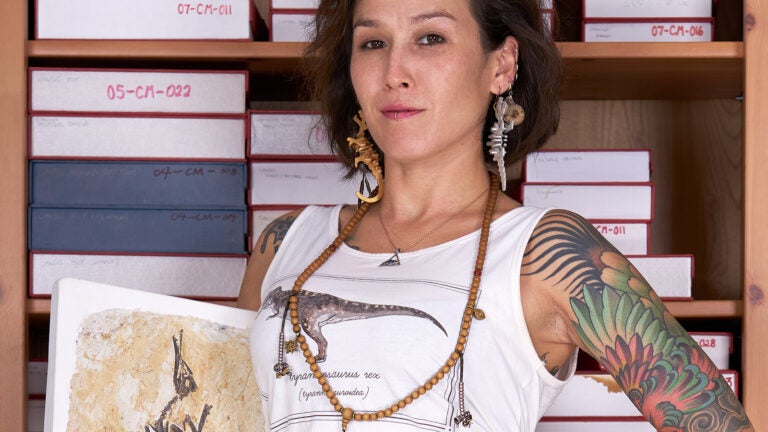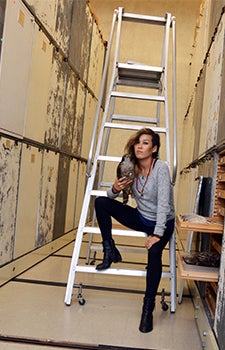
Paleontology’s Wild Child
Sitting in pride of place on paleontologist Jingmai O’Connor’s desk is a cast of Qiliania graffini, a fossilized bird she named after Greg Graffin, lead singer of Los Angeles punk band Bad Religion and himself a former paleontologist.
The cast was made for the award-winning European traveling exhibition “Rock Fossils,” which also features a trilobite named after Sid Vicious and a Silurian bristle worm named for King Diamond.
“Apparently, it’s a thing to name fossils after rock stars, metal artists and punk rock bands,” O’Connor says. “Graffin signed it and they sent it to me as a thank you, and I keep it here as one of my little crown jewels.”
The pierced and tattooed O’Connor, who’s been dubbed “The Punk Rock Paleontologist,” is one of the world leaders in her field. In January, she led a team of researchers to discover a perfectly preserved 99 million-year-old bird’s foot. This year, she received the Schuchert award, in recognition of talent under age 40, from the Paleontological Society.
She’s also been immortalized, along with her Quilania graffini fossil, in a comic book that was created during the “Rock Fossils” show. A massive Bad Religion fan, she was over the moon when Graffin sent her a signed copy.
So, given her sobriquet, it comes as something of a shock when she admits that — with the exception of Graffin’s band — she’s not really that into punk.
In fact, if you walk down the hallway past O’Connor’s office at the Institute of Vertebrate Paleontology and Paleoanthropology in Beijing, you’re more likely to hear faint dance music, punctuated with the odd Irish folk song. Her go-to song when she’s working isn’t a hardcore punk anthem, but the upbeat disco hit “Sunny” by Boney M., and her motto, she says, is “All dance music, all the time.”
No wonder then that, although she’s modest about her talents as a DJ, she’s in demand to spin the tables at professional meetings from Berlin to Dallas and provided the beats after the annual meeting of the Society of Vertebrate Paleontology in Brisbane, Australia, this fall.
A bohemian upbringing
How did O’Connor carve out such an extraordinary life? Most paleontologists, she says, get into the field very young. “They’re the kids who’re obsessed with dinosaurs.” Her own path was different.
The daughter of a Chinese American mother and an Irish American father who met in a Bulgarian folk dancing troupe in L.A., paleontology’s wild child was raised in a creative and bohemian family in Pasadena, California.
She grew up listening to Irish folk music, celebrating Chinese New Year and the Mid-Autumn Moon Festival, dancing, and playing violin with her parents in a folk band.
O’Connor’s father is an artist and the family struggled financially when she was a child, prompting her mother to go back to school at age 41 to earn a Ph.D. in Earth sciences from USC Dornsife to support them.
O’Connor clearly admires her mother’s work ethic, describing her as “a great role model.”
However, O’Connor says that, unlike her siblings, she wasn’t particularly academic as a child, preferring to draw manga over studying.
“My mom would always say, ‘You’re just lazy.’ And I’d say, ‘Why can’t she just accept that I’m not as smart as her? Why does it have to be that I’m lazy? Maybe I’m just stupid.’ But she saw through me. It really was laziness.”
She developed a fascination for evolution as a geology major at Occidental College. Her decision to specialize in feathered dinosaurs and other fossils of prehistoric birds drew her to study for her Ph.D. at USC Dornsife, where she could work with Luis Chiappe at the Natural History Museum of Los Angeles County (NHM).
“Once I got into grad school, I fell in love with what I was doing and worked incredibly hard,” O’Connor says, adding that she published more geology papers than anyone else in her year.
The age of dinosaurs
Armed with her Ph.D. from USC Dornsife, her decision to specialize in Mesozoic birds — which lived between 160 million and 65 million years ago, around the same time as large dinosaurs — drove her move to Beijing. There, she has access to thousands of well-preserved fossils from the Jehol Biota, an area of northeastern China that’s noteworthy for the particularly high diversity of fossils dating from between 131 and 120 million years ago that have been recovered. Fossils like these, O’Connor stresses, cannot be seen anywhere else in the world.
“Dinosaurs with wings on their arms and legs that look like they were hit by a car yesterday,” she says. “All these soft tissues preserved — which is very rare — and they’re 130 million years old.”
O’Connor mentions her good fortune and her gratitude frequently, almost as if pinching herself to remind herself it’s real.
Paying tribute to her doctoral advisors at USC Dornsife, Chiappe and David Bottjer, professor of Earth sciences, biological sciences and environmental studies, she says, “I’ve had a blessed trajectory in academia. I was just really lucky every step of the way.”
O’Connor shared the stage with Bottjer in September when they were honored as best junior and best senior paleontologist by the Geological Society of America.
“Paleontology has been such a wonderful, rewarding journey. I honestly feel like I’ve never worked a day in my life because I just love what I do so much, and none of it has ever been burdensome or difficult,” says O’Connor, who this year traveled to Europe, South Africa and Australia for field work and conferences.
Her decision to focus on birds was initially pragmatic, rather than borne out of love for her subject.
“I actually had no interest in birds whatsoever when I started,” she says. “I even had some very negative feelings towards birds, having been attacked by a rooster while doing fieldwork in Inner Mongolia.”
Her choice worked out, but only, she says, because she moved to China.
Her fascination with her chosen subject grew as she studied them.
“Birds are incredible creatures. There are three times as many species of living birds as species of living mammals. I always say, ‘It’s not the age of mammals, it’s still the age of dinosaurs.’”
O’Connor says she’s fascinated by the evolution of different flight styles and the way birds have adapted to conquer almost every ecological niche.
“Think of ostriches. Or penguins, which can’t fly anymore, but can live in harsh environments and basically fly under water. There are just a million and one incredible bird facts out there and millions more yet to be discovered.”
Mending broken wings

As she climbs the ladder to a distinguished academic career, Jingmai O’Connor says she has had “a blessed trajectory.” (Photo: Courtesy Jingmai O’Connor.)
She is determined to help young scientists, especially women, gain access to positive experiences similar to her own by teaching them to be more resilient and to stand up for themselves.
“For women in science, it’s very difficult,” says O’Connor, who admits she cried after her first two professional conferences.
“I bounced back and stood up to the challenge, but a lot of women don’t. They just quit. And that really sucks. So I try to take these people with broken wings who’ve had bad experiences and bring them back to academia and give them a better experience.”
Breaking the mold
Rocking multiple piercings and leggings that boast a T-Rex battling a unicorn, O’Connor’s larger-than-life sartorial style matches her outspoken, freedom-loving personality, making her stand out a mile from what she calls “the Teva-wearing geology types.”
“I’m definitely almost always wearing sneakers. Kicks. You can always tell it’s me from my footsteps because I’m always running down the hallway. ‘That’s Jingmai,’” O’Connor says, imitating her mother’s voice. “‘Doesn’t have time to just walk like a normal person.’”
Then there are the tattoos.O’Connor has 25 at last count, including a hummingbird skull; a trilobite; an ammonite; a crop circle; a plesiosaur skeleton (think the Loch Ness Monster); the Buddhist goddess of mercy, Guanyin; her first pet dog, Sampson; a coelacanth; and a giant Chinese phoenix, which she had transformed into an enantiornithine (Enantiophoenix) — the group of birds that were the subject of her dissertation.
While a grad student, she used to ride her skateboard around the hallways at the NHM and once had a predilection for mini-skirts and hot pants — sartorial choices that briefly got her into trouble with human resources.
“And then for a while, I had really long, wild hair and I never brushed it, and I was like, ‘“It’s Amazon princess hair.’”
Personal freedom to be herself is clearly important to O’Connor. In China, she’s found it.
“One of the great things about living in China is I can dress any way I want. As long as I’m highly productive, my institute doesn’t care what I do. Nobody checks in on me, nobody’s hounding me, and nobody knows where I am at any given time. It’s ultimate freedom combined with the ultimate financial resources to do anything I want — and then also the best fossils.”
Despite her fighting words, she admits, somewhat reluctantly, that age has brought moderation. Last winter, she chopped off her hair.
And while she’s certainly not ready to adopt the stereotypically conservative dress code so beloved of many paleontologists (those dreaded Tevas), she now concedes that “it’s important to be appropriate.”
The path to happiness
O’Connor clearly marches to the beat of her own drum. But while taking the road less traveled has led her to a profound sense of happiness and contentment, her life has not always been plain sailing.
Despite her outgoing personality, O’Connor suffered from depression for much of her life.
A believer in the power of spirituality, she blames much of society’s malaise on consumer culture. “Buying things is not going to make you happy,” she says firmly.
O’Connor follows Buddhist philosophy, which says all human suffering is self-created.
“It’s a constant battle not to fall into negative thinking,” she says, “but if we control our minds and realize that we create our own realities with the way that we choose to think about the world and about ourselves, then we create our own happiness.
“It’s a never-ending journey.”